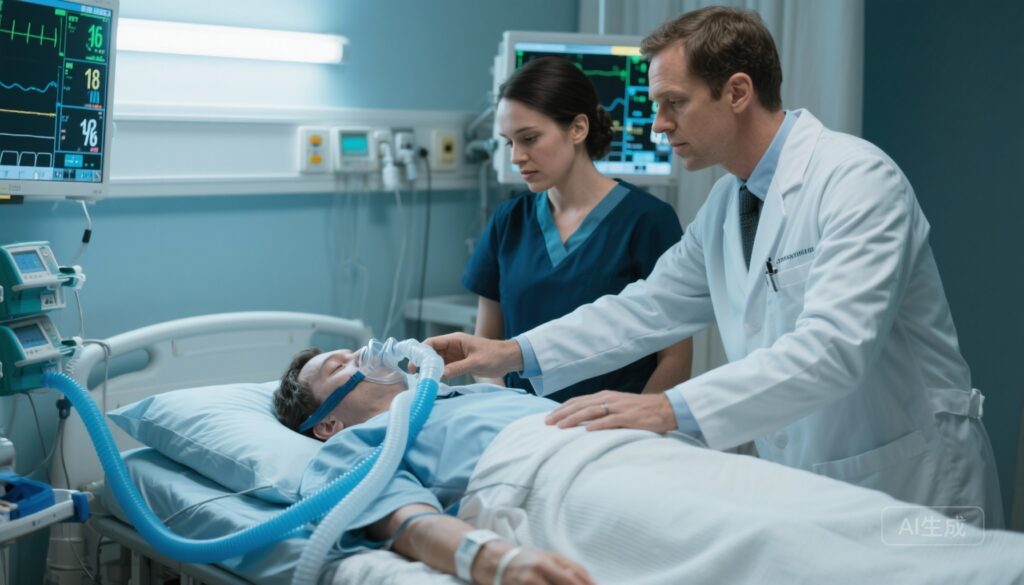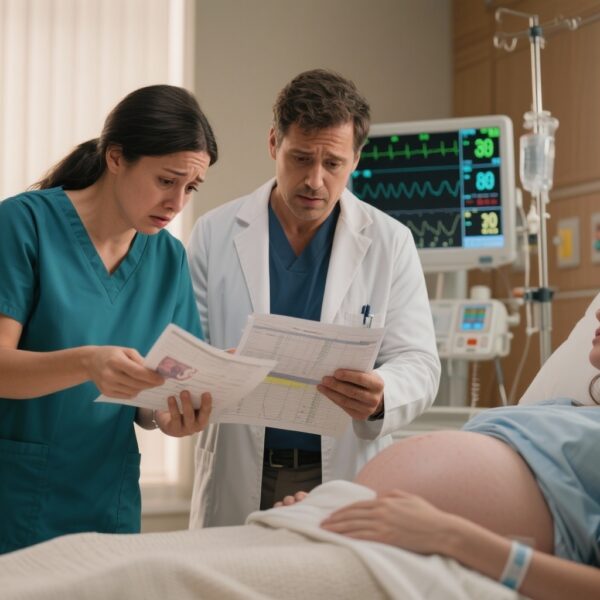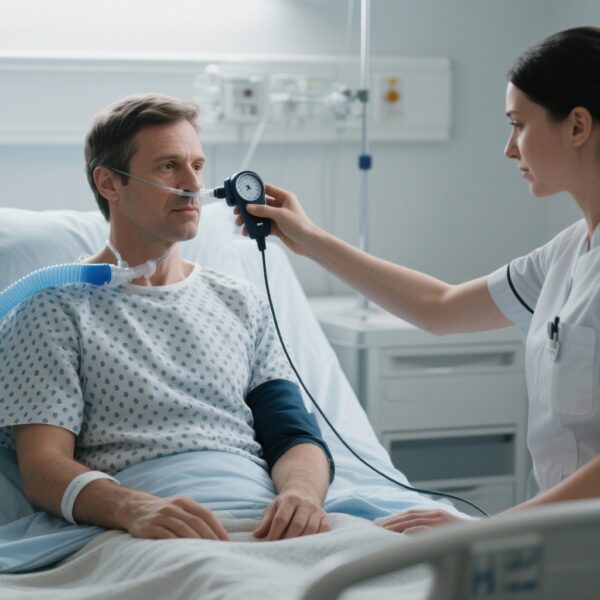Highlights
– A 2025 systematic review (Jung et al.) pooled data from nine studies (n = 1,045) comparing prolonged prone positioning (PPP, ≥24 h) versus shorter prone sessions (<24 h) in adults with ARDS and found no statistically significant effect on 90‑day mortality (HR 0.72, 95% CI 0.41–1.25).
– Secondary outcomes including oxygenation improvement and adverse events showed no clear benefits or harms; evidence was graded low to very low certainty (GRADE) due to imprecision and study limitations.
– Most included studies enrolled patients with COVID‑19 ARDS, limiting generalizability to non‑COVID ARDS. Current data do not support routine adoption of continuous PPP outside of well‑designed clinical trials.
Background and clinical context
Prone positioning is an established intervention to improve oxygenation and survival in moderate–severe acute respiratory distress syndrome (ARDS) when used as prolonged daily sessions (classically 12–16 hours per day), as demonstrated in landmark randomized trials such as PROSEVA (Guérin et al., N Engl J Med 2013). The physiological rationale is well understood: proning improves ventilation–perfusion matching, recruits dorsal lung units, reduces dorsal atelectasis and regional overdistension, and may mitigate ventilator‑induced lung injury by promoting more homogeneous lung stress and strain distribution.
Prolonged prone positioning (PPP), defined in the recent review as continuous proning for ≥24 hours per session, has been proposed as a strategy to sustain these physiological benefits, reduce the need for repeated turns (and attendant staff exposure and workload), and potentially reduce derecruitment when returning to supine. However, PPP could theoretically increase risks such as pressure injuries, device dislodgement, facial edema, and nursing complexity. In the COVID‑19 pandemic many centers experimented with different proning durations and protocols, producing an uneven evidence base.
Study design and methods of the systematic review
Jung and colleagues performed a systematic review and meta‑analysis that searched MEDLINE, CENTRAL, ClinicalTrials.gov, ISRCTN, ICTRP and the Cochrane COVID‑19 Study Register through 3 July 2025. Eligible studies enrolled adult ARDS patients and compared two distinct approaches: prone sessions of <24 hours (standard) versus sessions ≥24 hours (prolonged). Both randomized controlled trials (RCTs) and non‑randomized intervention studies (NRSIs) were eligible.
Risk of bias was assessed using ROB‑2 for RCTs and ROBINS‑I V2 for observational studies. The primary outcome was mortality (reported as hazard ratios or risk ratios). Secondary outcomes included oxygenation response and adverse events (pressure injuries, accidental extubation, hemodynamic instability). Pooled estimates used random‑effects models and the GRADE framework determined evidence certainty.
Key findings and detailed results
Study selection and characteristics
From 19,986 records the authors included nine studies totaling 1,045 patients. Four studies (two small RCTs, combined n = 112; and two NRSIs, n = 581) were judged to have low to moderate risk of bias. The remaining studies had higher risk of bias. The majority of studies enrolled patients with COVID‑19–associated ARDS, and protocols and co‑interventions varied between centers (ventilation strategy, sedation, neuromuscular blockade, timing of proning, and prevention measures for pressure injuries).
Mortality
The pooled analysis for 90‑day mortality included 641 patients and produced a hazard ratio of 0.72 (95% CI 0.41–1.25), indicating no statistically significant mortality reduction with PPP. Heterogeneity measured by I² was 0% (95% CI for I² 0–89%), meaning point estimate heterogeneity was low but confidence in that estimate is limited (wide CI for I²), and substantial between‑study variability could not be excluded.
Oxygenation and ventilatory outcomes
Across trials and observational cohorts no consistent or statistically significant improvement in sustained oxygenation (PaO2/FiO2) attributable to PPP was demonstrated when compared with standard shorter prone sessions. Some individual studies reported transient improvements in oxygenation, but these did not translate to consistent clinical outcome benefits.
Adverse events and safety
No pooled significant increase in catastrophic device‑related events (e.g., unplanned extubation) was observed. However, data on pressure injuries, facial edema, and skin complications were heterogeneous and sparse; overall the meta‑analysis found no statistically clear signal of increased harm but the evidence was imprecise. Given the low number of events and risk of reporting bias in observational studies, both increased harm and true safety remain plausible.
Certainty of evidence
Using GRADE, the authors judged the evidence to be of low to very low certainty because of risk of bias (nonrandomised designs and small RCTs), inconsistency (clinical and methodological heterogeneity), and imprecision (wide confidence intervals and limited events). The pooled estimates therefore should be interpreted cautiously.
Expert commentary and interpretation
How should clinicians interpret these findings? The physiological case for proning in ARDS remains strong and is supported by high‑quality evidence for protocols that use daily sessions of approximately 12–16 hours (PROSEVA). The incremental value of extending each proning session to ≥24 hours has biological plausibility (sustained recruitment, less derecruitment during supination), but the current clinical evidence summarized by Jung et al. does not confirm a patient‑centered benefit and is insufficient to exclude meaningful harm.
Key limitations of the reviewed literature that temper interpretation include:
- Dominance of small trials and observational studies with potential for selection bias and confounding (e.g., sicker patients may have been kept prone longer, or conversely, only more stable patients may have tolerated prolonged proning).
- Heterogeneity in patient populations, with most data coming from COVID‑19 ARDS; responses may differ in classic non‑COVID ARDS etiologies.
- Variability in co‑interventions (ventilator strategies, sedation/neuromuscular blockade, pressure‑injury prevention bundles), which could influence outcomes independently of proning duration.
- Limited statistical power leading to wide confidence intervals; the pooled HR of 0.72 could be consistent with a clinically important benefit or no effect.
From a safety standpoint, prolonged prone sessions carry plausible increased risks for pressure injuries and line/device complications. Careful implementation requires standardized protocols, prophylactic measures (pressure‑redistribution surfaces, frequent skin inspection where possible, secure airway devices), and staff training. These operational details are often underreported in observational studies and can determine the safety profile in practice.
Implications for practice and recommendations
Based on current evidence, prolonged continuous prone positioning (≥24 h per session) should not be adopted as routine practice for ARDS outside clinical studies. Intensivists should continue to follow guideline‑endorsed proning protocols—typically daily sessions of 12–16 hours for moderate–severe ARDS (as per major trials and guideline recommendations)—and ensure robust prevention strategies for pressure injuries and device security.
Clinicians considering PPP in individual cases should weigh the theoretical benefits against the uncertain evidence and possible increased risk of skin and device complications. If PPP is used, it should be within an institutional protocol with explicit staff training, documentation of indications, and predefined monitoring and safety checks.
Research priorities and trial design considerations
The review highlights the need for adequately powered, multicenter randomized controlled trials comparing PPP (≥24 h continuous sessions) with standard shorter proning sessions (e.g., 12–16 h/day), with standardized co‑interventions and prespecified patient‑centered outcomes (mortality, ventilator‑free days, incidence of pressure injuries, ICU length of stay, and long‑term functional outcomes).
Key design elements should include:
- Stratification by ARDS severity and by COVID vs non‑COVID etiology.
- Standardized ventilatory management (low tidal volume ventilation), sedation and neuromuscular blockade protocols, and prevention bundles for pressure injuries and tube security.
- Blinded adjudication of adverse events and standardized reporting of pressure injuries using validated grading systems.
- Sufficient sample size to detect clinically meaningful differences in mortality and important safety endpoints.
Conclusion and practical takeaways
Prolonged prone positioning (≥24 h per session) in ARDS remains an attractive physiological strategy but currently lacks robust evidence of benefit. The 2025 systematic review and meta‑analysis by Jung et al. pooled 9 studies (n = 1,045) and found no statistically significant mortality reduction (HR 0.72, 95% CI 0.41–1.25) nor consistent improvements in oxygenation or safety endpoints; overall evidence certainty was low to very low. Given the imprecision and risk of bias in available studies, routine adoption of PPP outside clinical trials is not recommended.
Clinicians should continue to apply established proning protocols supported by higher‑quality data (e.g., 12–16 hour sessions in moderate–severe ARDS), adhere to pressure‑injury prevention and airway safety measures, and enroll patients in well‑designed RCTs testing PPP when available.
Funding and clinicaltrials.gov
Readers should consult the primary publication (Jung C, Gillmann HJ, Stueber T. Crit Care. 2025 Nov 6;29(1):475) for details on review funding and declarations of interest. For ongoing trials investigating proning duration, search ClinicalTrials.gov and WHO ICTRP using terms “prone positioning” AND “ARDS” AND “duration” to identify registered randomized comparisons of prolonged versus standard proning strategies.
Selected references
Jung C, Gillmann HJ, Stueber T. Effectiveness and safety of prolonged prone positioning in adult patients with acute respiratory distress syndrome (ARDS): a systematic review and meta-analysis. Crit Care. 2025 Nov 6;29(1):475. doi: 10.1186/s13054-025-05712-0.
Guérin C, Reignier J, Richard JC, et al.; PROSEVA Study Group. Prone Positioning in Severe Acute Respiratory Distress Syndrome. N Engl J Med. 2013;368(23):2159–2168.
ARDS Definition Task Force; Ranieri VM, Rubenfeld GD, Thompson BT, et al. Acute respiratory distress syndrome: the Berlin Definition. JAMA. 2012;307(23):2526–2533.
Alhazzani W, Møller MH, Arabi YM, et al.; Surviving Sepsis Campaign Guidelines Committee including The Pediatric Subgroup. Surviving Sepsis Campaign: guidelines on the management of critically ill adults with COVID‑19. Intensive Care Med. 2020;46(5):854–887.
Note: The above list is selective and focused on key guideline and trial evidence relevant to prone positioning in ARDS.



